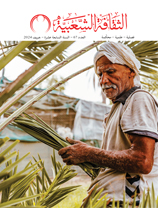Misdar... A Reflection of Nature
Issue 61

Professor Mohammed Al-Mahdi Bushra, Sudan
The researcher aims to clarify the terms used in this study and their link to the surrounding environment. Starting with the title, there is a reference to the environment, which is an integrated system that includes the land on which man lives, its climate, animals, plants, etc. and the roles they play.
The ‘poetry of the journey’, as defined by the renowned commentators, is poetry that portrays a journey on the back of an animal. This article calls for a study of the effect of nature or the environment on folk poetry, with an emphasis on the ‘misdar’ poem (the journey poem). The misdar can be found in most genres of folk poetry, including genres that praise the Prophet, because poets would describe the journey to the Holy Land and everything that they experienced.
In this study, the researcher attempts to examine the poet's relationship with the environment or nature using misdar, a well-known folkloric genre, as an example, while also observing the strong and intimate relationship between nature and poetry, which is evident in most, if not all, misdar poems.
The study shows that nature is a significant part of this lengthy poem, and that the poet describes nature successfully due to two factors: his knowledge of poetry and his attention to the smallest surrounding details.
This study also highlights the continuity of the misdar over a long period, from Wad Lafrash, who died in the Turkish era, until the present day, making it almost two centuries old. The misdar has also continued to absorb all forms of modernity, and it remained an appealing form, even for non-traditional poets (i.e., those who create their poems in writing rather than performing them orally), so the misdar can be described as a folkloric genre that never dies.




































































